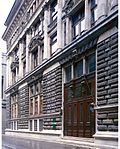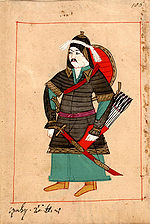The Ottoman Empire was one of the most dominant empires in the Mediterranean region, having lasted ~600 years and controlling much of the eastern and...
30 KB (3,804 words) - 05:28, 29 September 2024
the Ottoman Empire's economy and traditional society. The main sources of slaves were wars and politically organized enslavement expeditions in the Caucasus...
83 KB (10,922 words) - 22:39, 13 November 2024
Southeastern Europe, and also a distinctive social and fiscal class within the millet system of the Ottoman Empire, composed largely of Eastern Orthodox Christians...
14 KB (1,570 words) - 00:57, 19 October 2024
In the Ottoman Empire, women enjoyed a diverse range of rights and were limited in diverse ways depending on the time period, as well as their religion...
53 KB (7,004 words) - 21:03, 6 August 2024
The Ottoman Empire (/ˈɒtəmən/), also called the Turkish Empire, was an imperial realm that controlled much of Southeast Europe, West Asia, and North Africa...
262 KB (27,703 words) - 18:22, 22 November 2024
The Ottoman Empire developed over the years as a despotism[citation needed] with the Sultan as the supreme ruler of a centralized government[citation needed]...
14 KB (1,785 words) - 00:00, 17 November 2024
The Ottoman Empire, which existed from the 14th century until the early 20th century, had a complex and varied approach to issues related to sexuality...
31 KB (3,607 words) - 17:13, 16 November 2024
By the time the Ottoman Empire rose to power in the 14th and 15th centuries, there had been Jewish communities established throughout the region. The Ottoman...
50 KB (5,997 words) - 19:45, 14 November 2024
The rise of the Western notion of nationalism in the Ottoman Empire eventually caused the breakdown of the Ottoman millet system. The concept of nationhood...
79 KB (9,701 words) - 08:31, 13 November 2024
prevalent in the Ottoman Empire, with both men and women, as well as Christians, Jews, and Muslims engaging in the practice. Clients met prostitutes in a variety...
24 KB (3,286 words) - 19:02, 21 November 2024
In the late 18th century, the Ottoman Empire faced threats on numerous frontiers from multiple industrialised European powers. In response, the empire...
69 KB (8,964 words) - 04:54, 23 August 2024
In the Ottoman Empire, a millet (Turkish: [millet]; Ottoman Turkish: ملت) was an independent court of law pertaining to "personal law" under which a confessional...
48 KB (5,793 words) - 22:32, 9 November 2024
Rayah (category Social classes in the Ottoman Empire)
zimmi. In the early Ottoman Empire, raiyah were not eligible for military service, but from the late 16th century, Muslim raiyah became eligible to the distress...
4 KB (372 words) - 05:26, 28 October 2024
Askeri (category Social classes in the Ottoman Empire)
Under the Ottoman Empire, an askeri (Ottoman Turkish: عسكري) was a member of a class of military administrators. This elite class consisted of three main...
2 KB (242 words) - 02:34, 4 September 2022
The military of the Ottoman Empire (Turkish: Osmanlı İmparatorluğu'nun silahlı kuvvetleri) was the armed forces of the Ottoman Empire. It was founded...
45 KB (4,752 words) - 01:40, 15 November 2024
significant minority in the Ottoman Empire. They belonged to either the Armenian Apostolic Church, the Armenian Catholic Church, or the Armenian Protestant...
43 KB (4,770 words) - 15:27, 24 November 2024
In the Ottoman Empire each, and every millet (religious group) established a schooling system serving its members. Education, therefore, was largely divided...
18 KB (1,841 words) - 09:41, 8 November 2024
the Ottoman Empire made significant advances in science and technology, in a wide range of fields including mathematics, astronomy and medicine. The Islamic...
37 KB (4,454 words) - 19:05, 31 October 2024
The Transformation of the Ottoman Empire, also known as the Era of Transformation, constitutes a period in the history of the Ottoman Empire from c. 1550...
120 KB (15,418 words) - 12:53, 16 November 2024
The rise of the Ottoman Empire is a period of history that started with the emergence of the Ottoman principality (Turkish: Osmanlı Beyliği) in c. 1299...
76 KB (10,287 words) - 02:05, 15 November 2024
Lebanese nobility (redirect from Nobility in Lebanon)
The Lebanese nobility (Arabic: النبلاء اللبنانيون), also known as Manaseb (Arabic: المناصب) literally "Titles", is a social class that was formed during...
4 KB (405 words) - 15:10, 14 November 2024
The language of the court and government of the Ottoman Empire was Ottoman Turkish, but many other languages were in contemporary use in parts of the...
36 KB (3,766 words) - 05:07, 15 November 2024
endowments." The rise of the a'yan class was part of the decentralizing trend in the Ottoman Empire which began in the 16th century, and came to define the Empire's...
10 KB (1,305 words) - 19:55, 12 July 2024
The Ottoman Empire was governed by different sets of laws during its existence. The Qanun, sultanic law, co-existed with religious law (mainly the Hanafi...
18 KB (2,151 words) - 12:04, 17 November 2024
Ottoman clothing or Ottoman fashion is the style and design of clothing worn during the Ottoman Empire. While those of the palace and court dressed lavishly...
32 KB (3,185 words) - 15:13, 29 July 2024
The economic history of the Ottoman Empire covers the period 1299–1923. Trade, agriculture, transportation, and religion make up the Ottoman Empire's...
53 KB (6,654 words) - 07:50, 1 November 2024
Timariots (category Social classes in the Ottoman Empire)
Timariot (or tımar holder; tımarlı in Turkish) was the name given to a Sipahi cavalryman in the Ottoman army. In return for service, each timariot received...
7 KB (1,031 words) - 06:12, 8 August 2024
the Ottoman Empire. Its proponents believed that it could create the Unity of the Peoples, İttihad-ı Anasır, needed to keep millets from tearing the empire...
8 KB (963 words) - 00:47, 15 November 2024
Voynuks (redirect from Sanjak of the Voynuks)
voynugans or voynegans) were members of the privileged Ottoman military social class established in the 1370s or the 1380s. Voynuks were tax-exempt non-Muslim...
13 KB (1,425 words) - 11:52, 1 November 2024
In the Ottoman Empire, amira was a small group of elite, wealthy Ottoman Armenians living in urban centers. Conlin, Jonathan (2017). "The amiras and the...
2 KB (162 words) - 08:43, 2 May 2024















